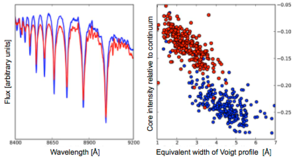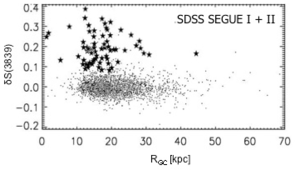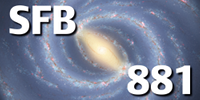Subproject A3: Structure and Formation of the Milky Way's Stellar Outskirts
Hans-Walter Rix (MPIA), Eva Grebel (ARI)
Study of the structure, an in particular the sub-structure, of the stellar halo and outer/thick disk, as a signpost of the past and ongoing dynamical assembly. The focus will be on the Milky Way's outskirts where dynamical time scales are long and therefore substructure still prominent.
Accretion events should leave observable signatures in the halo in the form of stellar streams and overdensities. Using the variability and light-curve information from time-domain surveys that became available during the first funding period, large numbers of short-period RR Lyrae and long-period carbon-rich variables could be identified and distances determined. Carbon stars are tracers of intermediate-age populations, which as such are not expected in the Galactic halo. Mapping the C star distribution in the Galactic halo, we recovered a number of previously known stellar streams (such as Sagittarius) as well as identified new overdensities. Among other things, these data will ultimately allow us to constrain the contribution of satellites sufficiently massive to have had extended star formation histories to the halo, and also impose constraints on the time of accretion. Like subproject A2, A3 had been intended to be based largely on Pan-STARRS data. A considerable effort was thus spent on uniformly calibrating the Pan-STARRS data. This time-consuming, but essential work has led to a many-color survey of the Milky Way that is better calibrated than the SDSS and covers a much larger area, including the Galactic disk. We developed novel techniques to identify RR Lyrae and blue horizontal branch stars in Pan-STARRS data, which will permit us to search for substructure in a data set much deeper than other wide-field surveys.

|

|
Publications
Martell, S.L., Smolinski, J.P., Beers, T.C., & Grebel, E.K.: "Building the Galactic halo from globular clusters: evidence from chemically unusual red giants"; 2011, A&A, 534, A136
Ruchti, G.R., et al.: "Metal-poor Lithium-rich Giants in the Radial Velocity Experiment Survey"; 2011, ApJ, 743, 107
Caliskan, S., Christlieb, N., & Grebel, E.K.: "Abundance analysis of the outer halo globular cluster Palomar 14"; 2012, A&A, 537, 83
Frank, M.J., Hilker, M., Baumgardt, H., Cote, P., Grebel, E.K., Haghi, H., Kuepper, A., & Djorgovski, S.L.: "The velocity dispersion and mass function of the outer halo globular cluster Palomar 4". 2012, MNRAS, 423, 2917
Vickers, J.J., Grebel, E.K., Huxor, A.P.: "Identifying Blue Horizontal Branch Stars Using the z Filter." 2012, AJ, 143, 86
Abbas, M.A., Grebel, E.K., Martin, N.F., Burgett, W.S., Flewelling, H., & Wainscoat, R.J.: "Newly Discovered RR Lyrae Stars in the SDSS - Pan-STARRS-1 - Catalina Footprint"; 2014, MNRAS,
441, 1242


